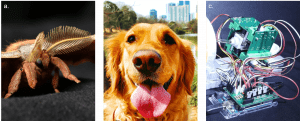 My favorite project during my PhD had an odd origin: a cheese smelling competition. Nearing the end of our moth studies, we received an invite to the IEEE hosted ISOEN conference which included a student competition to classify different cheeses based on the chemical profiles in the cheeses’ headspace (fancy way of saying “how much the cheese stinks”). Rather than using our own noses and sense of smell (in which case I would surely lose, just ask my wife), we had to use a specific sensor called a metal oxide sensor to do our smelling for us. While most other teams used hot plates or similar ways of heating up their cheeses to get the cheese to smell more (if you’ve ever had fondue you’ll know how much heating cheese can dissipate that smell), we had aspirations of using our device for TNT or other such uses which tend to not do so well being heated (kaboom!). Therefore, we took a tip from our moth studies and looked at how we might be able to manipulate the flow of the chemical-laden air onto a chemical sensor.
My favorite project during my PhD had an odd origin: a cheese smelling competition. Nearing the end of our moth studies, we received an invite to the IEEE hosted ISOEN conference which included a student competition to classify different cheeses based on the chemical profiles in the cheeses’ headspace (fancy way of saying “how much the cheese stinks”). Rather than using our own noses and sense of smell (in which case I would surely lose, just ask my wife), we had to use a specific sensor called a metal oxide sensor to do our smelling for us. While most other teams used hot plates or similar ways of heating up their cheeses to get the cheese to smell more (if you’ve ever had fondue you’ll know how much heating cheese can dissipate that smell), we had aspirations of using our device for TNT or other such uses which tend to not do so well being heated (kaboom!). Therefore, we took a tip from our moth studies and looked at how we might be able to manipulate the flow of the chemical-laden air onto a chemical sensor.
The arrangement of our the cheese-flowing-air system created an internal flow environment like a human nose, rather than an external flow environment such as a moth antennae. Therefore, we looked at how other “sensing systems” move air to enable sensing. Macrosmatic mammals (hairy creatures that rely on their noses to survive) quickly became the target animals of interest for us to investigate to learn how to improve our machine’s sense of smell. Our initial device, Gaseous Recognition Oscillatory Machine Integrating Technology (aka GROMIT – the most famous moon-cheese sniffing dog) utilized the inhalation and exhalation pattern of mammals to place third in the international ISOEN cheese sniffing competition. For the next few years, we honed GROMIT’s capabilities and used it to shed light on why mammals sniff at the frequency they do. This research was recently published in the well known journal Nature Communications and detailed the trade off that a fast sniff enables quick odor recognition, but too fast a sniff makes the amplitude of the signal comparable to noise.
